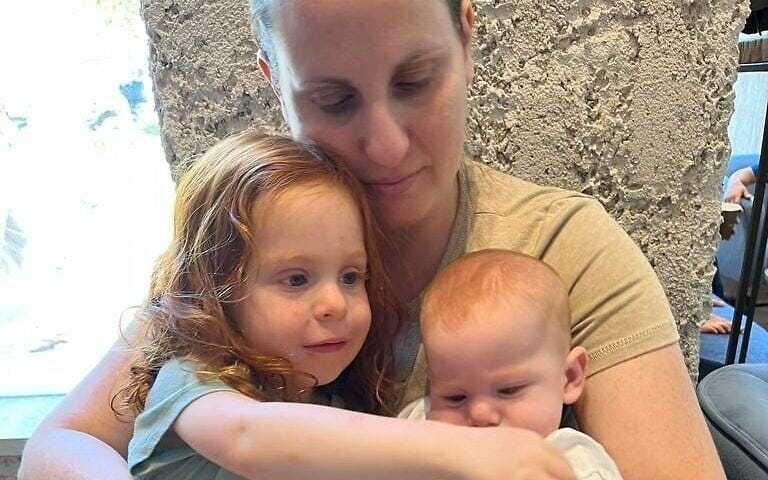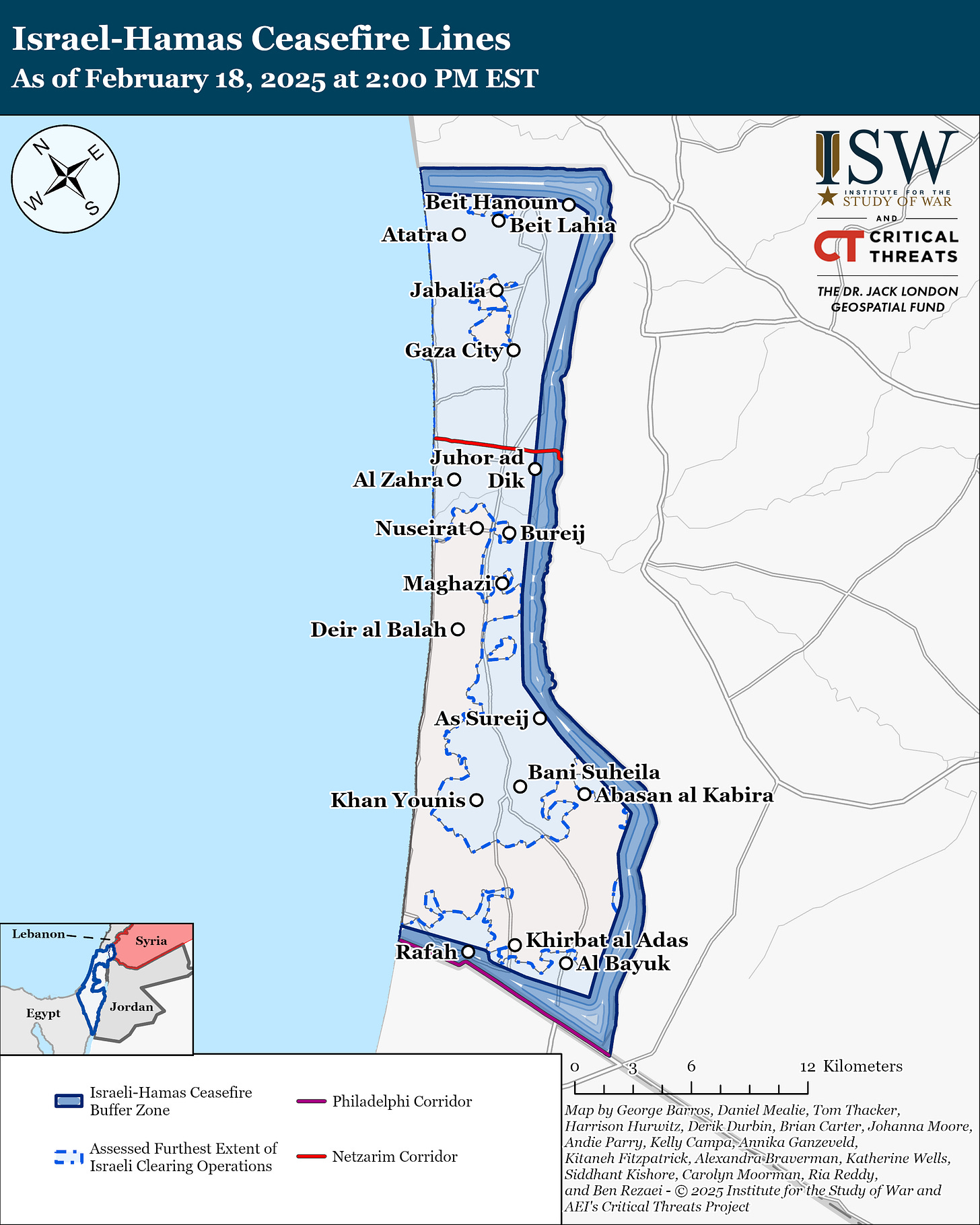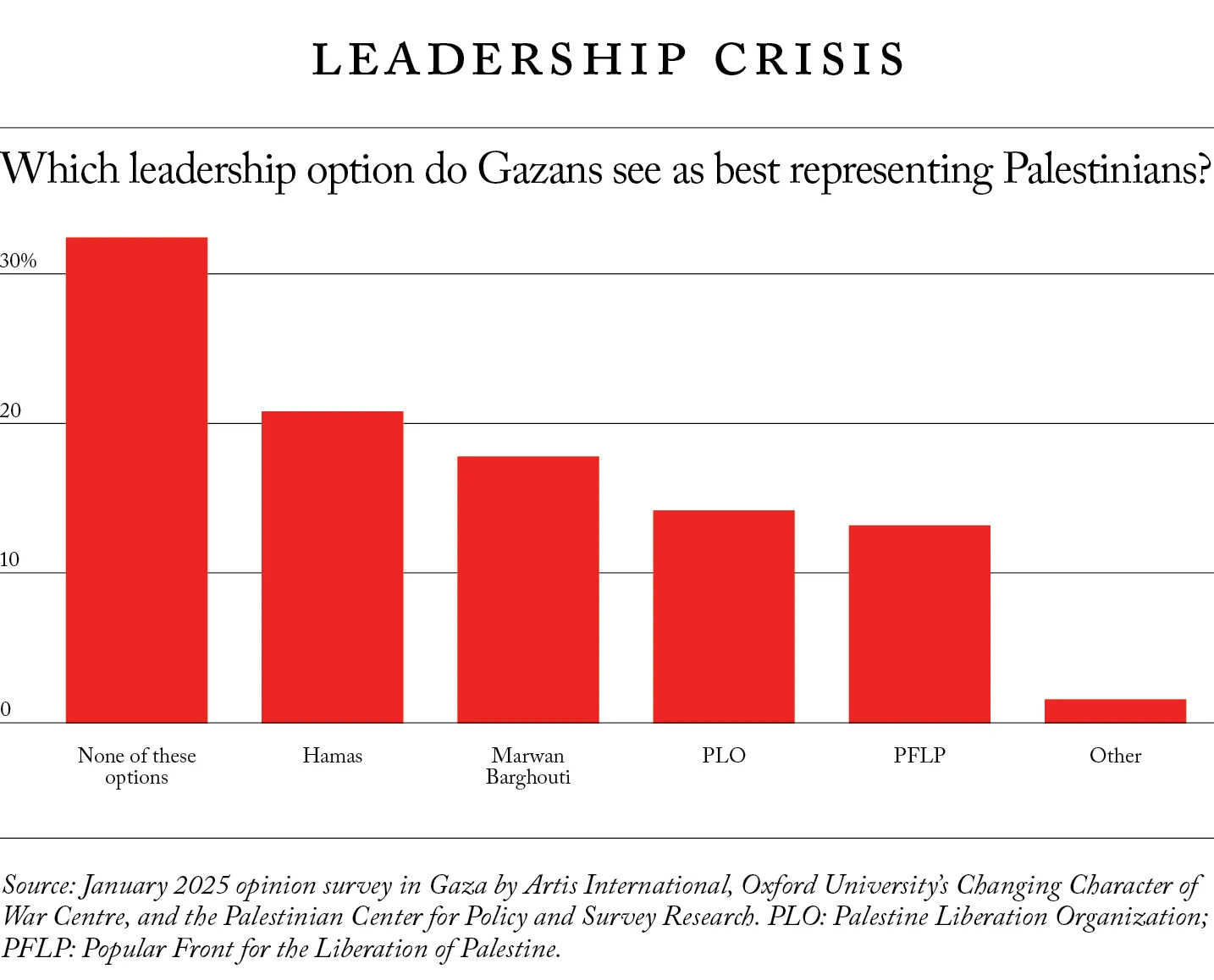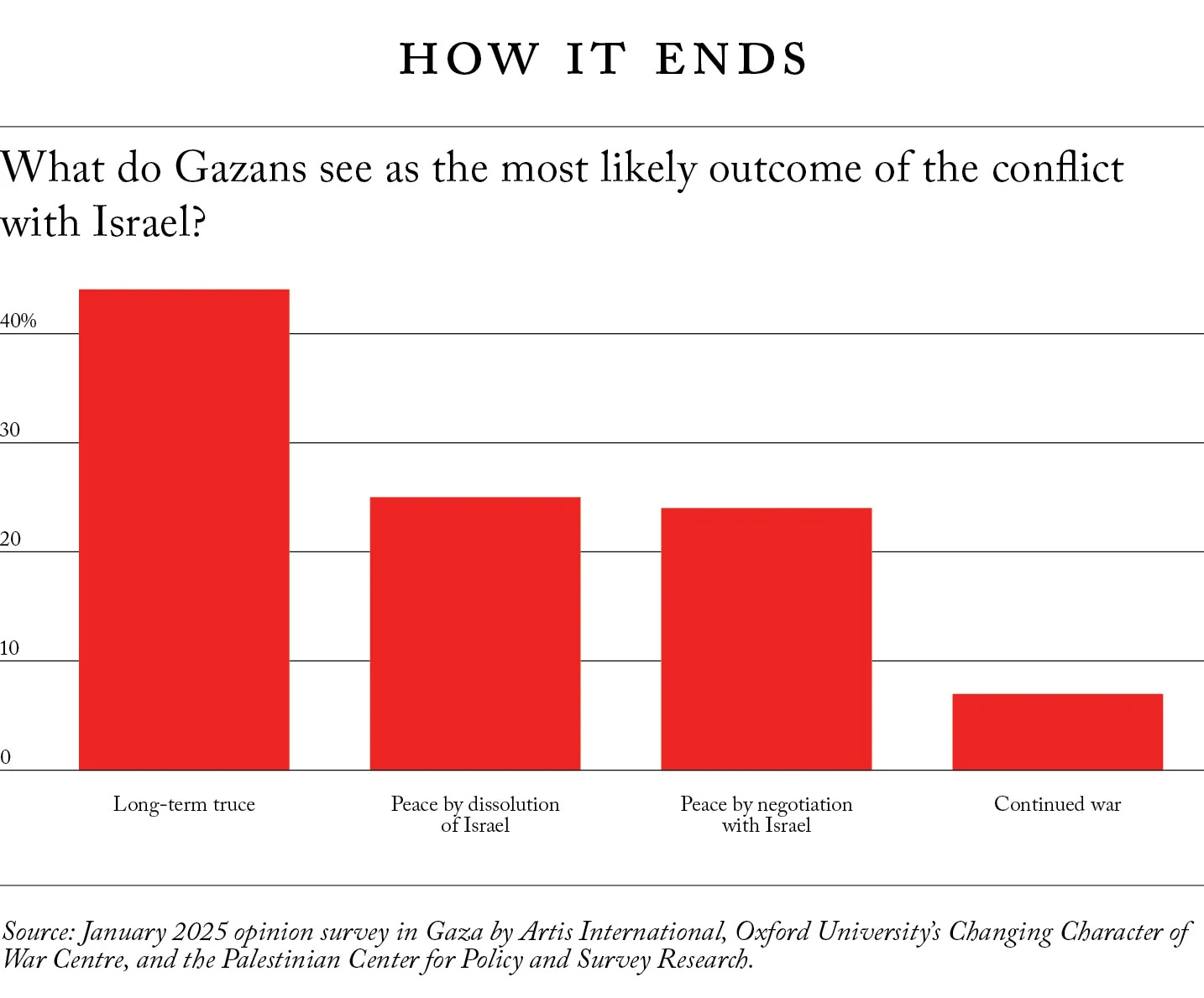Hostage Update
According to the Times of Israel: all six remaining living hostages slated to be released in the first phase of the Gaza ceasefire deal will be freed Saturday, Israeli and Hamas officials said Tuesday, in a surprise move apparently linked to growing worries that the ceasefire and captive release deal in the Gaza Strip could collapse.
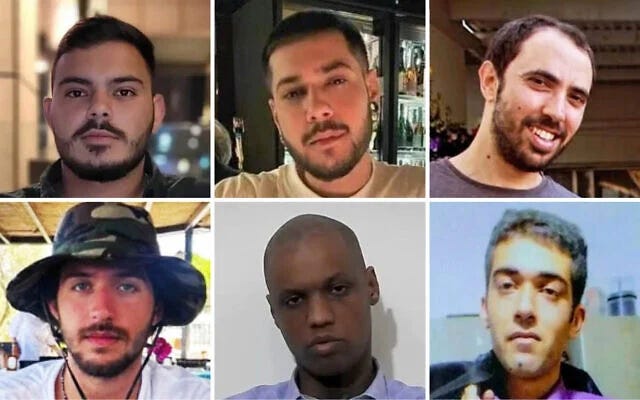
Hamas leader in Gaza Khalil al Hayya said that among the six living hostages will be Israelis Avera Mengistu and Hisham al-Sayed, who have been held by Hamas since entering the Strip on their own in 2014 and 2015, respectively. The other four — Tal Shoham, Omer Shem-Tov, Omer Wenkert, and Eliya Cohen — were kidnapped during the October 7, 2023, Hamas attack on southern Israel.
On Thursday, Hamas announced that it will return the bodies of four deceased hostages, indicating that members of the Bibas family would be among the four bodies to be handed over on Thursday.
Statement from the Bibas family:
In the past few hours, we have been in turmoil following Hamas spokesperson's announcement about the planned return of our Shiri, Ariel, and Kfir this Thursday as part of the hostages' remains release phase. We want to make it clear that while we are aware of these reports, we have not yet received any official confirmation regarding this matter. Until we receive definitive confirmation, our journey is not over. We ask the media and the public to respect our privacy and refrain from contacting us about this matter.
[MUST READ] The Meaning of Kfir Bibas by Seth Mandel in Commentary
Yarden Bibas was released this month by Hamas after nearly 500 days in captivity, and the terror group is claiming it will soon deliver the bodies of his wife, Shiri, and two sons, Ariel and Kfir. Ariel was four when he was taken on Oct. 7, 2023, and Kfir was nine months old.
To be Jewish has meant experiencing a crushing disappointment in the world since the Hamas attacks that started this war. A stray line in one of the many articles about the Bibas family today unintentionally offers a crystal clear explanation for that disappointment. “For many Israelis,” the New York Times writes, “the story of the Bibas family has become a symbol of the brutality of the Hamas-led Oct. 7 attack.”
That sentence is accurate. But in another universe, one where the “international community” cares a whit for justice and human decency, the sentence would read this way: “For everyone, the story of the Bibas family has become a symbol of the brutality of the Hamas-led Oct. 7 attack.”
In such a world, the faces of the Bibas children would be everywhere at all times. In the world in which we live, by contrast, posters with those faces get torn down from bulletin boards.
The crimes against the Bibas family are indeed the symbol of the anti-civilizational menace that is Hamas—but also of the cowardice of the political and cultural leaders of the enlightened West. Yes, we should be ashamed of our fellow Americans, who not only won’t mention the Bibas family but won’t even learn the name of a single American hostage held in Gaza throughout the war.
As the “pro-Palestinian” mobs filled the streets of every major city to celebrate Hamas’s slaughter, Jews around the world looked at them dumbfounded; they kidnapped a baby. How much does one have to hate Jews to side with the monsters who kidnap babies?
Kfir’s face became a symbol of the conflict because it represented a line that had been crossed and cannot be uncrossed. Members of Congress giddily attended tentifada demonstrations that were no longer simply “pro-Palestine” or “anticolonial”; they were about defending those who stole Kfir from his home and dragged him to Gaza where, according to Hamas, he died.
Kfir became a symbol because he is the answer to every relevant question about this conflict. His case is the war boiled down to its essence. Kfir is the dividing line. In a better world, there’d be no one standing on the wrong side of it.
There are now currently 70 hostages taken on 10/7 currently in captivity in Gaza (there are 73 hostages remaining in total)
24 hostages have been released so far in the first phase of the agreement
14 are now remaining on the list for release during the first stage of the ceasefire (pictures below)
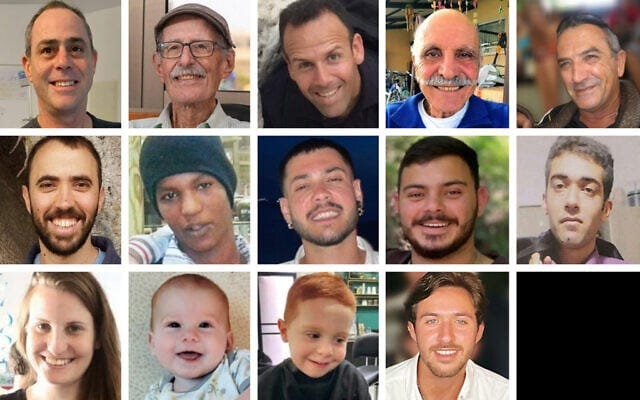
Top row from left: Tsahi Idan, Oded Lifshitz, Ohad Yahalomi, Shlomo Mantzur, Itzik Elgarat. Middle row from left: Tal Shoham, Avera Mengistu, Eliya Cohen, Omer Wenkert, Hisham al-Sayed. Bottom row from left: Shiri Bibas, Kfir Bibas, Ariel Bibas, Omer Shem-Tov (Courtesy: Hostage Family Forum) 6 of the 14 remaining hostages still to be freed are alive and 8 are dead
3 are members of the Bibas family (Shiri Silberman Bibas and her two children, Ariel, who was 4 years old when taken captive, and Kfir, who was 9 months when taken captive)
5 hostages are Americans: Meet the Five American Hostages Still Held By Hamas: Edan Alexander and Itay Chen are assumed to be alive, while Gadi Haggai, Judi Weinstein Haggai, and Omer Neutra have been confirmed to have been killed.
24 hostages will remain in captivity after Phase I and have not been declared dead.
4 are soldiers
7 are residents of the Gaza border communities
11 were abducted from the Nova music festival
2 are foreign workers, one from Thailand and one Nepal
On October 7th, a total of 261 Israelis were taken hostage.
During the ceasefire deal in November of 2023, 112 hostages were released.
182 hostages in total have been released or rescued
The bodies of 40 hostages have been recovered, including 3 mistakenly killed by the military as they tried to escape their captors.
8 hostages have been rescued by troops alive
Of the 73 hostages still theoretically in Gaza
35 hostages have been confirmed dead and are currently being held in Gaza
Thus, at most, 38 living hostages could still be in Gaza.
Hamas is also holding 2 Israeli civilians who entered the Strip in 2014 and 2015 (civilians Avera Mengistu and Hisham al-Sayed, who have been held in Gaza for a decade), as well as the body of 1 IDF soldiers who was killed in 2014 (Lt. Hadar Goldin’s body remains held in the Gaza Strip)
Casualties (no change)
1,850 Israelis have been killed including 846 IDF soldiers since October 7th (no change since Sunday)
The South: 407 IDF soldiers during the ground operation in Gaza have been killed (no change since Wednesday)
The North: 131 Israelis (84 IDF soldiers) have been killed during the war in Northern Israel (no change since Wednesday)
The West Bank: 63 Israelis (27 IDF and Israeli security forces)
Additional Information (according to the IDF):
2,581 (+1 since Sunday) IDF soldiers have been injured during ground combat in Gaza, including at least 497 (no change since Sunday) who have been severely injured.
5,713 (+3 since Sunday) IDF soldiers have been injured since the beginning of the war, including at least 848 (no change since Sunday) who have been severely injured.
The Gaza Casualty Count:
According to unverified figures from the Hamas-controlled Gaza Health Ministry, 51,600 total deaths have been reported, with a civilian/combatant ratio: 1:1.
[MUST READ] Report: Questionable Counting: Analysing the Death Toll from the Hamas-Run Ministry of Health in Gaza by Andrew Fox with The Henry Jackson Society
On October 7th, Ohad Hemo with Channel 12 Israel News – the country’s largest news network, a leading expert on Palestinian and Arab affairs, mentioned an estimate from Hamas: around 80% of those killed in Gaza are members of the organization and their families.”
Read this well documented piece from Tablet published in March: How the Gaza Ministry of Health Fakes Casualty Numbers
The Associated Press, an outlet with a demonstrated anti-Israel bias, conducted an analysis of alleged Gaza death tolls released by the Hamas-controlled "Gaza Health Ministry." The analysis found that "9,940 of the dead – 29% of its April 30 total – were not listed in the data" and that "an additional 1,699 records in the ministry’s April data were incomplete and 22 were duplicates."
The Israeli Ministry of Foreign Affairs publishes official details on every civilian and IDF casualty.
Antisemitism
BBC Documentary on Gaza Intentionally Obscures Connections to Terror Groups by Jewish Onliner
Investigative journalist David Collier's detailed exposé suggests that BBC staff may have deliberately manipulated the documentary to promote an anti-Israel narrative while disregarding the terror affiliations of those featured in it.
One of the most disturbing aspects of the documentary that Collier revealed is the background of the narrator, Abdullah Ayman Eliyazouri. His family’s connections to Hamas were not disclosed in the documentary, despite his father, Dr. Ayman Al-Yazouri, serving as the Deputy Minister of Agriculture in Gaza’s Hamas-run government. A photo uncovered by Collier shows Ayman Al-Yazouri at a ceremony in Gaza wearing Hamas colors. Furthermore, his grandfather Ibrahim al-Yazouri was a founder of Hamas.
Similarly, Khalil Abushammala, initially introduced in a Channel 4 clip as Abdullah’s father, has been identified as the director of the NGO Al Dameer, which has documented links to the Popular Front for the Liberation of Palestine (PFLP). The PFLP’s official website even published a statement in support of Abushammala.
Collier’s investigation also uncovered social media posts by Abdullah’s father that praised Hamas terrorists who murdered Israeli civilians.
Collier noted the issues with the BBC releasing a documentary co-produced by Jamie Roberts, who lacks knowledge of Gaza’s political landscape, and does not speak Arabic or Hebrew... The documentary’s second producer, Yousef D. Hammash, has previously worked on anti-Israel content, a detail not highlighted in promotional materials.
The documentary’s visual material was filmed by two local Gazan cameramen, Amjad Al Fayoumi and Ibrahim Abu Ishaiba (also known as Ebraheem Ateef). A deeper look into Al Fayoumi’s social media shows that he openly saluted the October 7 massacre.
Collier highlighted how, for a region with nearly two million residents, the BBC repeatedly featured the same individuals who have already appeared in international media coverage. The narrator, Abdullah Ayman Eliyazouri, was prominently featured in a Channel 4 piece under a different name... raising questions about whether the documentary provides a truly diverse representation of voices from Gaza.
The implications of these revelations are significant. If the BBC has aired a documentary without fully disclosing the affiliations of its featured subjects, it calls into question its editorial standards and commitment to impartial journalism.
Link: BBC Documentary on Gaza Intentionally Obscures Connections to Terror Groups
The Columbia Network Pushing Behind the Scenes to Deport and Arrest Student Protesters by Natasha Lennard & Akela Lacy with The Intercept
When President Donald Trump issued an executive order threatening to deport international students involved in pro-Palestine protests, advocates expressed immediate concern that the move would target demonstrators — particularly Muslim and Arab students — for engaging in activity protected by the First Amendment.
Some members of the Columbia University community, however, leapt at the chance to get young people they claim are 'supporters of Hamas' detained and deported. Several people on a large WhatsApp group, Columbia Alumni for Israel — which counts over 1,000 members, including parents, at least one current student, and Columbia professors — welcomed Trump’s plan.
Identifying the Columbia student-Hamas-sympathizers who show up is key to deporting those with student visas," former Columbia’s Teachers College assistant professor Lynne Bursky-Tammam said in the chat, according to screenshots from the WhatsApp group obtained by The Intercept.
Critics of the school’s policies toward protesters say Columbia administrators have done little to intervene with attacks on students and faculty. On Thursday, two Columbia professors wrote an op-ed demanding that the school to condemn calls to deport its students.
“The Palestine exception to the First Amendment, to our right to free speech, has been something that’s been ongoing for so many years,” said Sabiya Ahamed, a staff attorney at the civil liberties group Palestine Legal, which filed a complaint about anti-Palestinian discrimination at Columbia that led to a federal investigation.
Several of the students named in the WhatsApp group have also been targeted by name by groups like Canary Mission, which publishes profiles of students involved in anti-Zionist activism, or in social media posts by the group “Documenting Jew Hatred on Campus at Columbia U,” which at least one chat member is involved in.
For the WhatsApp group members who seek deportations and terrorism charges, the school’s actions against pro-Palestine students are regularly described as grossly insufficient. Palestine Legal’s Ahamed said, however, that the actions of groups like Columbia Alumni for Israel are aided by the school’s own crackdown on pro-Palestine protests.
Link: The Columbia Network Pushing Behind the Scenes to Deport and Arrest Student Protesters
Red Cross fails Jews with lack of hostage visits, Hamas condemnation by Matthew Garces with The Jerusalem Post
Since its founding in May 1881, the Red Cross has been revered as a cornerstone in the global effort to provide humanitarian aid to suffering populations. Over the years, the organization has garnered the trust and support of millions for its dedication to serving those who cannot help themselves. However, recent actions have illuminated a disturbing pattern of failure in how it treats Jews.
According to the International Committee of the Red Cross’s (ICRC) mission statement, the organization 'protects the lives and dignity of victims of war and internal violence and provides them with assistance,' but since the outbreak of the Israel-Hamas War on October 7, 2023, the Red Cross has utterly failed in carrying out its mission. For nearly 500 days since the war began, the Red Cross has failed to visit and provide medical assistance to a single hostage while in captivity, in total and complete violation of their mission statement.
On February 8, 2025, in accordance with the ceasefire deal, Hamas released three Israeli hostages: Eli Sharabi, Ohad Ben Ami, and Or Levy. The state of Eli, Ohad, and Or sent shockwaves throughout the globe: their images were wrought with signs of malnutrition and neglect. They bore a haunting resemblance to Holocaust survivors, their emaciated forms and hollow eyes echoing the unimaginable horrors of history. Were Eli, Ohad, and Or not deserving of medical treatment?
Seeing the horrifying and inhumane treatment of the innocent hostages brought me back to the time in 2016 I visited the Theresienstadt Concentration Camp (often referred to as Terezin) 30 miles north of Prague. Upon my visit, I learned an appalling fact of history: on June 23, 1944, the Red Cross sent a delegation to inspect Terezin. The Nazis commenced Operation Embellishment, an attempt to make temporary improvements to the camp to give the visitors a positive impression. They cleaned up the camp, deported many Jews to Auschwitz to minimize the appearance of overcrowding, and built fake shops and cafes to imply the Jews lived in relative comfort, among other cover-ups.
In light of the Red Cross’s behavior, one must ask: How can an institution so central to global humanitarian efforts turn a blind eye when it matters most? How can the Red Cross, an institution entrusted with protecting human dignity, continue in 2025 the same grievous failures it began committing since the outbreak of the war – once again abandoning the Jewish people in their darkest hour? The Red Cross needs to provide answers and rectify its failures. Anything less would be a betrayal of the very mission they claim to uphold – and of the countless lives that depend on their integrity.
Link: Red Cross fails Jews with lack of hostage visits, Hamas condemnation
Israel/Middle East Related Articles
Agam Berger, the Hostage Who Kept the Sabbath by Meir Soloveichik with The Wall Street Journal
Thus goes a familiar story in the history of the Jewish people: A Jew, kidnapped from the Holy Land and taken to enemy territory, refuses to eat whatever nonkosher food is provided to him. So Scripture informs us of Daniel, who found himself in the court of Nebuchadnezzar II, king of Babylon. Daniel refused to 'defile' himself with the forbidden food of the king and requested that he be allowed to subsist on seeds.
As Agam Berger, 20, was freed from Hamas’s clutches in Gaza last week, fellow hostages who had made it home before her revealed astounding details about her time in captivity. According to Israeli news reports, Ms. Berger’s parents were informed that she had refrained from engaging in any activities on Saturday that would violate the Sabbath. Thus when 'Hamas terrorists ordered Agam to cook food . . . she steadfastly refused.' Another hostage, Liri Albag, 20, reportedly described how Ms. Berger refrained from eating nonkosher meat throughout her time in captivity, which doubtless involved enormous sacrifice.
The same can’t be said of Gaza, where Ms. Berger was held in cruel captivity. It is, by all accounts, a society soaked with Jew-hate. Ms. Albag told her father that she encountered derision, and a total lack of sympathy, from every person with whom she came into contact: 'I sat with children 8 and 4 who were cursing ‘the Jews.’' On the day Ms. Berger was released, the world witnessed a seething mob of Gazans surrounding and deriding her as she was transferred to the Red Cross.
It is with this in mind that her name becomes all the more striking. Agam is Hebrew for a small pool in the desert. Psalm 114 describes the wonders of God, who 'turned the rock into water,' agam, 'the flint into a fountain.' Remarkably, as Yeshiva University’s Rabbi Daniel Feldman noted, Jews around the world recited this psalm as part of their liturgy on Jan. 30, the day Ms. Berger was released.
Her testimony offers a magnificent metaphor. For religious Jews, the story of modern Israel is one of Jewish courage, as well as an unfolding providential plan of which they are a part. This was precisely the message Ms. Berger delivered to her people on attaining freedom. As an Israel Defense Forces helicopter brought her home, she held aloft a white board, on which she had written a series of Hebrew phrases: 'In the path of faith I have chosen / and on the path of faith I have returned. Thank you to all the people of Israel, and to the heroic soldiers of the IDF / There is no one like you in the world.'
President Trump Faces Two Major Issues in the Middle East: The future of Gaza is not one of them by Michael Mandelbaum in The Jewish Strategic Tribune
President Donald Trump has enhanced his reputation for unpredictability in foreign policy with his novel suggestion, at a joint press conference with Israeli prime minister Benjamin Netanyahu, that the people currently living in the Gaza Strip be evacuated and that the United States assume control of that territory and rebuild it. The president is surely correct that continuing the previous arrangements in Gaza, with the Islamic fundamentalist terrorist organization Hamas in charge, will only lead to more terror, death, destruction, and misery. Something new is certainly needed.
What the President has proposed undoubtedly qualifies as thinking outside the box; but for it to come to pass, others would have to engage in similarly unorthodox thinking, and at this point that is not likely. The people now living in Gaza are unlikely to leave; even if they wanted to do so, no country in the region appears willing to receive them; nor is any country likely to supply the policing needed to ensure that Hamas does not retain its grip there; and American taxpayers would probably balk at contributing to the reconstruction of Gaza…
On Iran, Mr. Trump has resumed the policy of maximal economic pressure that he adopted during his first term in office and that the Biden administration eased. Such pressure has as its major purpose preventing the Islamic Republic from pushing its nuclear program... At the press conference, Mr. Trump stated categorically that Iran will not be allowed to complete its nuclear quest. Yet he also expressed interest in negotiations with the Iranian government.
On the Palestinian question, a succession of American presidents... has held two convictions: first, that its resolution – which all of them came to believe entailed creating a Palestinian state – was imperative for the peace of the region and American interests there; and second, that establishing such a state was eminently feasible. Both propositions were and are false. Middle Eastern governments have expressed rhetorical solidarity with the Palestinians but have demonstrated repeatedly that their policies are geared to their own interests... They prefer to continue their decades-long campaign to destroy Israel.
In short, the President approaches two crucial Middle Eastern issues with conflicting impulses, indeed with two different foreign-policy personae: the tough and sturdy guarantor of America’s interests and allies, ready to use force to defend them, on the one hand; and the virtuoso deal-maker who can broker agreements where others have failed, on the other. Which will prevail in the Iranian and Palestinian cases? Stay tuned.
Link: President Trump Faces Two Major Issues in the Middle East: The future of Gaza is not one of them
Trump's Gaza Plan and Its Larger Meaning by Jonathan Schanzer’s Pundicity
The Disruptor in Chief is back. Donald Trump's frenetic issuance of executive orders in the early weeks of his second term has Washington gasping for breath. But it was a press conference—Trump's February 4 White House joint appearance with visiting Israeli Prime Minister Benjamin Netanyahu—that may set the world on a new course. Reading from a piece of paper that was likely penned by a former Middle East adviser from his first term, Trump announced his intent to vacate the embattled Gaza Strip of its inhabitants and then rebuild the Mediterranean coastal enclave, which has been reduced to rubble since the Hamas assault against Israel on October 7, 2023. This would be an American development project, said the real estate president.
The disbelief expressed in many quarters in response to Trump's plan—which would be better characterized as a notion—centers on its viability. In three ways, it seems dead on arrival. The first is the viability of a large-scale relocation of Gazans. The second is the viability of any effort to redevelop the Gaza Strip itself. And the third is the viability of Trump's implicit effort to replace the dream of a 'two-state solution' with a long-term and immensely expensive real estate project.
As of now, there is no way Arab states will accept hundreds of thousands of Gazans as refugees, either temporarily or otherwise. The idea is taboo; it is an axiom of Arab thinking that Palestinians are expected to remain in Palestinian areas to serve the interests of Palestinian nationalism and put constant pressure on Israel. [...] Second, what leader alive today aside from Trump looks at Gaza—a misbegotten piece of land devoid of natural resources, synonymous with terrorism and misery—and sees a golden future? Trump articulated the obvious: This tiny territory, roughly the size of the District of Columbia, must undergo a wholesale transformation. Who is actually interested enough to effect such a transformation? Who will pay for it? Who will keep the territory secure when terrorists have every interest in interfering with its reconstruction?
…After the Hamas slaughter of 1,200 Israelis and the predictably harsh Israeli military response, the possibility of a 'two-state solution' has lost its salience. No Israeli politician or party of any size will consent to, or even have a concrete discussion about, the creation of a Palestinian state for a very, very long time, and everyone knows it. After the homicides, Israel will not commit suicide. Something must replace this self-defeating delusion if the Arab world, the Israeli peace movement, the American left, and much of the international community are to speak in any reasonable way about the region's future.
In the wake of Trump's press conference, Saudi Arabia came out swinging. The Kingdom rejected any attempts to displace the Palestinians and added for good measure that its stance on the absolute need for a Palestinian state is not negotiable. This probably played well among the Saudi population and the surrounding Arab states looking to Saudi Arabia for leadership. But the Saudi position must be understood for what it is: an opening gambit in renewed negotiations between Trump and Saudi Crown Prince Mohammed Bin Salman.
Trump has opened the negotiations by suddenly advocating a plan that looked outrageous to the eyes of the Arabs, including the mass evacuation of Gaza and the rebuilding of the coastal enclave—which, Trump says, they should actually pay for. Whether the Arabs know it or not, Trump ripped a page right out of his own book, The Art of the Deal. His offer is something that the other side could never accept. But now, the onus is on the Arabs to counter if they don't like it. Should things continue in this vein, maybe then and only then will the terms of a feasible agreement come into focus.
For Donald Trump, who has unfinished business on the brain, the question is how to harness that process and push it in the right direction. His reelection prompted a pause in Iran's multifront war. This was cheered by the region. His re-initiation of the 'maximum pressure' campaign against Iran also inspires the confidence of the Arab states that fear Iranian aggression. The president has yet to announce his support of the people of Iran, who will be instrumental in toppling their reviled regime. A successful attack on the Iranian nuclear program, should Trump decide to take such a risk, would be a game-changer in this regard, given Arab hostility toward the regime.
What Gazans Want by Scott Atran & Ángel Gómez with Foreign Affairs
In the weeks since Israel’s fragile January 19 cease-fire and hostages-for-prisoners deal with Hamas, the issue of what should happen to Gaza and its 2.1 million inhabitants has come starkly into view. The war has reduced much of Gaza to ruins, with its schools, hospitals, civilian infrastructure and ecology now largely destroyed and a huge portion of its population lacking adequate shelter. The constant threat of the cease-fire’s breakdown has fueled its own daily dread of further devastation.
Strangely absent from this debate are Gazans themselves. It is reasonable to assume that more than 15 months of pulverizing conflict have changed the perceptions of ordinary civilians in the territory about what they want for their future, how they see their land, who they think should be their rulers, and what they consider to be the most plausible pathways to peace.
In fact, a survey we conducted in Gaza in early January... tells a more complicated story. The survey found that although Hamas’s popular appeal has declined precipitously since the early months of the war, current alternatives to the group draw even less support, which opens the way for Hamas to shore up its influence over Gaza again
The war has also strengthened rather than weakened Gazans’ commitments to maximalist political goals, while eroding support for a two-state solution. Perhaps most strikingly, the survey showed that the people of Gaza continue to retain strong core values related to their Palestinian and religious identity and their attachment to the land, values that they intend to uphold even if doing so requires great personal sacrifice.
For Gazans more widely, the willingness to sacrifice themselves for common goals this far into a brutal war strongly suggests that they are unlikely to give up their struggle simply in exchange for personal and family security. This raises questions about various international 'day after' plans in Gaza, which seem to assume that providing personal safety and livelihood—cessation of hostilities combined with aid delivery, tents, and basic necessities—can stabilize the territory even without Palestinian self-determination.
After waging 15 months of 'total war' and achieving many of its declared material objectives, Israel may be further from pacifying Gaza than ever. This is not just because Israel has failed to offer anything resembling a political strategy or a plausible plan for a Palestinian future while further radicalizing Palestinians to seek revenge for relatives killed and homes lost. It is also because Gazans, at least the most committed among them, believe that their identity and place in the world are more imperiled than ever: a sentiment not unlike the one that inspired the establishment of the Jewish state and fostered its people’s still intense will to fight.
Link: What Gazans Want: A Brutal War Has Weakened Support for Hamas—but Made Peace With Israel Harder
Regular sources include JINSA, FDD, IDF, AIPAC, The Paul Singer Foundation, The Institute for National Security Studies, the Alma Research and Education Center, Yediot, Jerusalem Post, IDF Casualty Count, the Washington Institute for Near East Policy, Institute for the Study of War, Tablet Magazine, Mosaic Magazine, The Free Press, and the Times of Israel


